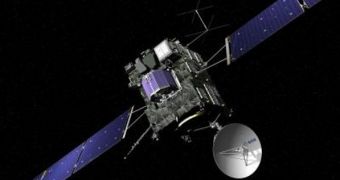The European Space Agency (ESA) spacecraft Rosetta is currently en route to meet up with the comet 67P/Churyumov-Gerasimenko on the fringes of the solar system. The two are scheduled to first see each other in 2014. The probe was launched back in 2004, and it has completed about 4,500 million kilometers of its 7,100-million-kilometer journey to its destination. In 2005 and 2007, the craft did two swings around the Earth, in order to pick up speed and correct its trajectory, and this flight was the last one it did before leaving the solar system, only to return in 2015.
ESA officials announced this morning that the spacecraft moved past the Earth at exactly 08:45:40 CET, and that the point of closest approach was recorded somewhere over the southern parts of the Indonesian island of Java. The minimum altitude the craft had in respect to the Earth was of 2,481 kilometers, and mission planners say that it was in contact with the ESA Maspalomas station in Spain at all times. Already traveling at about 13.34
The spacecraft is scheduled to meet the comet 67P/Churyumov-Gerasimenko in the early months of 2014. Once in its vicinity, it will drop a lander on the surface of the space rock, and then continue to pursue and study it for the next couple of years, as the “couple” makes its way towards the inner solar system again. Its mission is currently scheduled to conclude around December 2015, although an extension is not off the table yet. The final Earth-assist stage is required in order for the spacecraft to gain the correct inclination and speed for the rest of its journey.
As the spacecraft swung by, astronomers and astrophysicists also kept an eye on minute speed variations that it recorded, as this might hold the key to unlocking a cosmic mystery. Over the years, as more and more missions through the solar system were launched, and needed to move close to the Earth for the gravity-assist stage, astronomers noticed something peculiar. The space probes seemed to be accelerated differently than estimated, in that they either emerged from the flight moving faster, or slower than anticipated, but never at the “correct speed.”
“It's a mystery as to what is happening with these gravity events. Some studies have looked for answers in new interpretations of current physics. If this proves correct, it would be absolutely ground-breaking news,” Trevor Morley says. The expert is a Rosetta lead flight dynamics specialist based at the ESA European Space Operations Center (ESOC), in Darmstadt, Germany.

 14 DAY TRIAL //
14 DAY TRIAL //